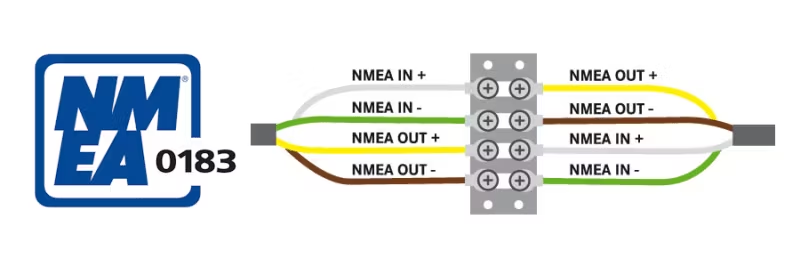Cart
Discount: 0.00 DKK
Discount: 0.00 DKK
Digital Skipper |28/03, 2025

NMEA 0183 is a standard used to enable communication between marine electronic devices. This standard has become a cornerstone in marine electronics and is used by everything from GPS devices to autopilots and echo sounders. In this blog post, we will delve deeper into what NMEA 0183 is, how it works, and why it is so important.
NMEA stands for National Marine Electronics Association, and 0183 is a specific standard they have developed to ensure that different marine electronic devices can communicate with each other. The standard defines a common language that the devices use to exchange data, allowing them to work together seamlessly.
NMEA 0183 uses a simple serial communication protocol where data is sent in the form of sentences. Each sentence begins with a $ sign and ends with a checksum to ensure that the data has not been corrupted during transmission. Here is an example of an NMEA 0183 sentence:
$GPGGA,123519,4807.038,N,01131.000,E,1,08,0.9,545.4,M,46.9,M,,*47
This sentence contains information about a GPS position, including time, latitude, longitude, and altitude.
There are many different types of sentences in the NMEA 0183 standard, each with its own specific meaning. Here are some of the most common:
Here are the 10 most common NMEA 0183 abbreviations:
These abbreviations are used to describe different types of data sent between devices, such as GPS receivers, echo sounders, autopilots, and other instruments.
NMEA 0183 is important because it enables interoperability between different manufacturers' devices. This means that a GPS device from one manufacturer can communicate with an autopilot from another manufacturer, giving boat owners the flexibility to choose the best devices for their needs without worrying about compatibility issues.
There are several ways to connect NMEA 0183 devices to ensure effective communication and data transfer between them. Here are some of the most common methods:
NMEA 0183 is a standard for communication between marine electronic devices. It has evolved through several versions, with the latest version being 4.11. NMEA 0183 specifications (version 2 and later) should at a minimum meet the requirements of the computer standard RS422 (Standard EIA-422-A). RS422 uses differential driving, which means it uses two wires to send data, making it less sensitive to interference and allowing for longer cable lengths.
NMEA 0183 originally used single-ended driving but has later been updated to use differential driving (RS422). RS422 is not strictly compatible with RS232, but most RS422 drivers work as single-ended drivers if only one output wire is used. In summary, the main difference is that RS422 uses differential driving to reduce interference and allow for longer cable lengths, while NMEA 0183 originally used single-ended driving but has been updated to use the RS422 specification.
Although NMEA 0183 is still widely used, the newer NMEA 2000 standard has begun to take over. NMEA 2000 offers higher data transfer speeds and support for more devices on the same network. Despite this, NMEA 0183 is likely to remain relevant for many years to come, especially for older devices and systems.
https://web.nmea.org/External/WCPages/WCWebContent/webcontentpage.aspx?ContentID=364